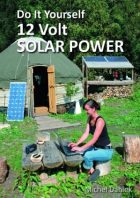
Do It Yourself 12 Volt Solar Power
Michel Daniek
More information on Amazon.com
Practical guide book explaining the various parts and specifications for setting up your own solar electricity system.
Download plans from Treehouse Guides
Projects for beginners, with or without trees
Having an electricity supply in a treehouse adds comfort, especially if you plan to use the treehouse for overnight stays. If you are already close to a source of mains electricity then connecting the treehouse can be as simple as running an extension cable via a RCD. For more remote locations, or those too far from an electrical outlet, solar power is an easy source of low voltage electricity. To usefully integrate solar power you need to install a complete system so that you have a steady reliable supply of electricity that can be used during the night or for higher power devices.
Even low voltage systems can be dangerous if incorrectly setup, with fire caused by poor connections or undersized wiring being the main concern. Using an inverter for higher voltages comes with an electrocution risk if improperly installed. Consult a qualified electrician to check your particular setup to confirm that it can be operated safely.
Most treehouses are only occupied for small period of the day, but the sun's light can be collected for as long as it shines. A solar system consists of a collector (solar panel), a storage device (some form of battery) and a charge controller. The panel provides a relatively low powered supply of electricity that gradually accumulates in the battery. It is then available for use at any time and at higher loads than the panel could support by itself. Some electronics are required to make this work correctly, the most important of which is a charge controller. This device is essentially a switch connecting the panel and battery. When the solar panel is receiving sunlight the controller will connect it to the battery so that it charges. If the sunlight fades, the panel is disconnected to avoid it acting as a drain on the battery. Once the battery reaches its fully charged state it is disconnected from the panel to avoid overcharging.
The battery also tends to regulate the output voltage. A solar panel by itself will vary in voltage widely over the course of the day, sometimes too low or high to properly run your devices. By routing the power through the battery, the output voltage range is greatly reduced and you will be able to run devices as long as the battery has a good charge level.
A fuse should be incorporated into the system in at least one place to prevent too much current being drawn and overheating occuring. The main point in the system is on the output from the battery, where the fuse needs to cut off the circuit if the current being drawn is too much for the wiring. A fuse can also be placed between the solar panel and charge controller. For arrays of panels connected together expert advice should be found to correctly protect the circuit from overloading.
It is safer and more efficient to use devices that match the battery voltage (12/24V), but if you need to increase the voltage to match mains levels (110/240V) you will need to use an inverter. This connects to the battery and will step up the voltage and also convert it to alternating current (AC) to match mains electricity. The stability of the voltage level and the quality of the DC to AC conversion has an impact on how well some devices will work, and this is one reason why some inverters are more expensive than others.
Inverters are sized by output in watts (W) but also vary in conversion efficiency. The inverter capacity should easily cover the expected load so that all the cabling and electronics are well within safety limits.
Inverters and charge controllers are not 100% efficient and the lost power will be converted to heat. It is very important to allow plenty of ventilation to allow this heat to escape easily, otherwise a fire risk could be created. Cheaper, less efficient devices will produce more waste heat so at higher loads you may wish to get a more efficient model to make cooling easier.

More information on Amazon.com
Practical guide book explaining the various parts and specifications for setting up your own solar electricity system.